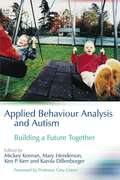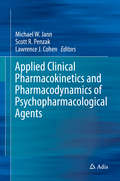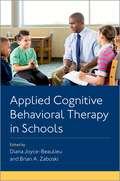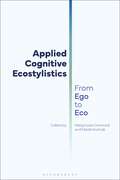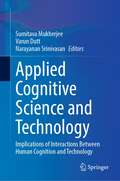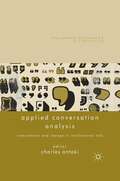- Table View
- List View
Applied Behaviour Analysis and Autism: Building A Future Together (PDF)
by Karola Dillenburger Ken P. Kerr Mary Henderson Mickey KeenanApplied Behaviour Analysis (ABA) is an effective behavioural treatment programme widely used with children with autism to improve socially significant behaviours. This practical book gives detailed guidance on how to develop a tailored ABA programme that includes the key features of ABA: detailed individual behaviour assessment, reinforcement strategies to encourage new behaviours and systematic programme implementation. Chapters also include individual family case studies and discuss relevant issues such as day-to-day management of programmes for both younger and older children, collaboration in the community, sibling support, school-based programmes and obtaining services. The international contributors offer practical advice on the approach needed for the successful implementation of ABA. Applied Behaviour Analysis and Autism will be a key resource for parents, teachers, social workers, psychologists, researchers, nurses, health visitors and anyone with an interest in improving the ability to cope with the world of children with autism.
Applied Behaviour Analysis and Autism: Building A Future Together
by Ken P. Kerr Mary Henderson Karola Dillenburger Mickey KeenanApplied Behaviour Analysis (ABA) is an effective behavioural treatment programme widely used with children with autism to improve socially significant behaviours. This practical book gives detailed guidance on how to develop a tailored ABA programme that includes the key features of ABA: detailed individual behaviour assessment, reinforcement strategies to encourage new behaviours and systematic programme implementation. Chapters also include individual family case studies and discuss relevant issues such as day-to-day management of programmes for both younger and older children, collaboration in the community, sibling support, school-based programmes and obtaining services. The international contributors offer practical advice on the approach needed for the successful implementation of ABA. Applied Behaviour Analysis and Autism will be a key resource for parents, teachers, social workers, psychologists, researchers, nurses, health visitors and anyone with an interest in improving the ability to cope with the world of children with autism.
Applied Child Study: A Developmental Approach
by Anthony D. Pellegrini David F. BjorklundChild study is a very complex field. Human beings, and children, specifically, are very complex beings. Consequently, simple answers and solutions to problems are very often just that: too simple. This text presents principles and methods for studying children in the varied contexts in which they live and function. These theories and methods can be used as a kind of "tool kit" for application in a variety of situations by the people who work with children such as researchers, parents, educators, pediatricians, nurses, social workers, and child psychologists, to name but a few. In short, the book is written for people interested in how to examine and describe children as well as those interested in creating educational environments for children.
Applied Child Study: A Developmental Approach
by Anthony D. Pellegrini David F. BjorklundChild study is a very complex field. Human beings, and children, specifically, are very complex beings. Consequently, simple answers and solutions to problems are very often just that: too simple. This text presents principles and methods for studying children in the varied contexts in which they live and function. These theories and methods can be used as a kind of "tool kit" for application in a variety of situations by the people who work with children such as researchers, parents, educators, pediatricians, nurses, social workers, and child psychologists, to name but a few. In short, the book is written for people interested in how to examine and describe children as well as those interested in creating educational environments for children.
Applied Clinical Pharmacokinetics and Pharmacodynamics of Psychopharmacological Agents
by Michael W. Jann Scott R. Penzak Lawrence J. CohenThis book is a comprehensive resource on psychotropic medications, detailing the latest methods for defining their characteristics, their use in different patient populations, and drug-drug interactions; an important collection of information forclinicians, students, researchers, and members of the pharmaceutical industry alike. The first section provides the foundational principles of these drugs. Mathematical modeling of parameters that affect their entryto,and exit from, the central nervous system (CNS) compartment are presented on an individual basis and then applied to target populations with specific disease states. Methods and characteristics that inform the transfer of these drugs from the laboratory bench to use in patient care are discussed, including imaging techniques, genetics and physiological barriers, such as the blood-brain barrier. The second section describes the characteristics of specific agents,nominally arranged intodifferent therapeutic categories and with reference crossover use in different disease states. The pharmacologic characteristics of different drug formulations are explored in the context of their ability to improve patient adherence. The third section focuses on drug-drug interactions.Psychotropic medications from different categories are frequently prescribed together,or alongside medications used to treat comorbid conditions, and the information provided is directly relevant to the clinic, as a result. The clinical application of pharmacokinetics and pharmacodynamics of CNS agents has made significant progress over the past 50 years and new information is reported by numerous publications in psychiatry, neurology, and pharmacology.Our understanding of the interrelationship between these medications, receptors, drug transporters, as well as techniques for measurement and monitoring their interactions,isfrequently updated. However, with information presented on a host of different platforms, and in different formats, obtaining the full picture can be difficult. This title aims to collate this information into a single source that can be easily interpreted and applied towards patient care by the clinical practitioner, and act as a reference for all others who have an interest in psychopharmacological agents.
Applied Cognitive and Behavioural Approaches to the Treatment of Addiction: A Practical Treatment Guide
by Luke Mitcheson Jenny Maslin Tim Meynen Tamara Morrison Robert Hill Shamil WanigaratneThis new book offers professionals a practical guide to the psychological treatment of all substance abuse, including tobacco, alcohol, stimulant drugs, cannabis and opiates. It focuses on CBT interventions, which have the strongest evidence base for effectiveness in treating addictive disorders. Written by an author team highly experienced in the treatment of addiction, Applied Cognitive and Behavioural Approaches to the Treatment of Addiction will be accessible to a wide range of professionals, such as specialist nurses, drug counsellors and mental health graduate workers. The author team are all at the South London and Maudsley NHS Trust, UK.
Applied Cognitive Behavioral Therapy in Schools
by Diana Joyce-Beaulieu Brian A. ZaboskiCognitive behavioral therapy (CBT) is an evidence-based psychosocial intervention appropriate for a plethora of problems including anxiety, depression, and emotion dysregulation. School-based practitioners can alleviate some of these concerns in young people by applying CBT in school settings, but to do so successfully, CBT must be modified to accommodate busy academic schedules, to include both parents and teachers, and to align with academic or other accommodations. Applied Cognitive Behavioral Therapy in Schools is a textbook for students and guide for practitioners looking to apply CBT in school settings. In this text, the assembled authors unpack CBT's theoretical development and provide an overview of its research support and applications for children and adolescents. Essentials for all CBT practitioners, such as behavioral activation, cognitive restructuring, and exposure and response prevention are covered in detail. The book also highlights relevant laws and ethics codes and walks readers through basic therapy micro skills. Special attention is paid to culturally responsive mental health services and key skills like psychoeducation, relaxation training, and mindfulness. The book concludes with tips for incorporating technology to supplement therapy and enhance client engagement. Printable handouts for children and families, as well as therapist worksheets are included in addition to school-based case studies that illustrate CBT's flexibility. Applied Cognitive Behavioral Therapy in Schools is the go-to resource for students learning CBT, early career school-based practitioners and more seasoned professionals looking to draw more proactively on CBT skills in practice.
Applied Cognitive Behavioral Therapy in Schools
by Diana Joyce-Beaulieu Brian A. ZaboskiCognitive behavioral therapy (CBT) is an evidence-based psychosocial intervention appropriate for a plethora of problems including anxiety, depression, and emotion dysregulation. School-based practitioners can alleviate some of these concerns in young people by applying CBT in school settings, but to do so successfully, CBT must be modified to accommodate busy academic schedules, to include both parents and teachers, and to align with academic or other accommodations. Applied Cognitive Behavioral Therapy in Schools is a textbook for students and guide for practitioners looking to apply CBT in school settings. In this text, the assembled authors unpack CBT's theoretical development and provide an overview of its research support and applications for children and adolescents. Essentials for all CBT practitioners, such as behavioral activation, cognitive restructuring, and exposure and response prevention are covered in detail. The book also highlights relevant laws and ethics codes and walks readers through basic therapy micro skills. Special attention is paid to culturally responsive mental health services and key skills like psychoeducation, relaxation training, and mindfulness. The book concludes with tips for incorporating technology to supplement therapy and enhance client engagement. Printable handouts for children and families, as well as therapist worksheets are included in addition to school-based case studies that illustrate CBT's flexibility. Applied Cognitive Behavioral Therapy in Schools is the go-to resource for students learning CBT, early career school-based practitioners and more seasoned professionals looking to draw more proactively on CBT skills in practice.
Applied Cognitive Ecostylistics: From Ego to Eco
by Malgorzata Drewniok, Marek Kuźniak, andThis book offers an up-to-date account of one of the most influential strands of eco-research: cognitive ecostylistics. The onset of the 1970s saw a global shift in scholarly perspective upon the relation between egocentric and ecocentric views of the world. The so-called eco-turn was not only linguistic at its roots, but engaged the bulk of academic thought in social sciences and humanities. Cognitive ecostylistics invites a multidisciplinary approach to the study of the conceptual relations between oral or written texts and their impact on the environment. This volume is a collection of the latest research that seeks to apply the theory and methodology developed over the last 40 years to both literary and real-life texts, engaging with a wealth of examples from First World War poetry and Anne of Green Gables through to Condé Nast Traveller hotel descriptions. Exploring the cultural effects of the eco-turn, the collection engages the reader in the problem of the present-day Anthropocene, manifested as Ego-Eco tensions at the level of communicating self-needs and the needs of the Other. Divided into two parts, it considers first the human-angled semiotic interplay contained within the universe of people, before examining the problem of semiotic engagement of texts as extraneous to the human, highlighting crucial aspects of nature, culture, and beyond.
Applied Cognitive Ecostylistics: From Ego to Eco
This book offers an up-to-date account of one of the most influential strands of eco-research: cognitive ecostylistics. The onset of the 1970s saw a global shift in scholarly perspective upon the relation between egocentric and ecocentric views of the world. The so-called eco-turn was not only linguistic at its roots, but engaged the bulk of academic thought in social sciences and humanities. Cognitive ecostylistics invites a multidisciplinary approach to the study of the conceptual relations between oral or written texts and their impact on the environment. This volume is a collection of the latest research that seeks to apply the theory and methodology developed over the last 40 years to both literary and real-life texts, engaging with a wealth of examples from First World War poetry and Anne of Green Gables through to Condé Nast Traveller hotel descriptions. Exploring the cultural effects of the eco-turn, the collection engages the reader in the problem of the present-day Anthropocene, manifested as Ego-Eco tensions at the level of communicating self-needs and the needs of the Other. Divided into two parts, it considers first the human-angled semiotic interplay contained within the universe of people, before examining the problem of semiotic engagement of texts as extraneous to the human, highlighting crucial aspects of nature, culture, and beyond.
Applied Cognitive Psychology: An Information-Processing Framework (Psychology Revivals)
by Paul BarberOriginally published in 1988 Applied Cognitive Psychology draws on the psychology of perception, attention, and cognition to give an understanding of some everyday activities and skills. Paul Barber focuses on processes involved in selecting simple actions, face perception, reading, and tasks requiring attention skills. He uses practical problems as starting points for discussion, including mental overloading in air-traffic controllers, cooker-hob design, the use of Photokit/identikit, and reading from computer screens. The book also examines the strengths and limitations of the basic analytical approach of ‘information-processing’ in psychology. As well as providing a textbook for students of psychology and ergonomics, Applied Cognitive Psychology will still be welcomed by those from other disciplines – management studies, education, sports science – who need to understand skilled behaviour in applied settings.
Applied Cognitive Psychology: An Information-Processing Framework (Psychology Revivals)
by Paul BarberOriginally published in 1988 Applied Cognitive Psychology draws on the psychology of perception, attention, and cognition to give an understanding of some everyday activities and skills. Paul Barber focuses on processes involved in selecting simple actions, face perception, reading, and tasks requiring attention skills. He uses practical problems as starting points for discussion, including mental overloading in air-traffic controllers, cooker-hob design, the use of Photokit/identikit, and reading from computer screens. The book also examines the strengths and limitations of the basic analytical approach of ‘information-processing’ in psychology. As well as providing a textbook for students of psychology and ergonomics, Applied Cognitive Psychology will still be welcomed by those from other disciplines – management studies, education, sports science – who need to understand skilled behaviour in applied settings.
Applied Cognitive Psychology: A Textbook (Challenges And Controversies In Applied Cognition Ser.)
by Douglas J. Herrmann Carol Y. Yoder Michael Gruneberg David G. PayneThe field of applied cognitive psychology represents a new emphasis within cognitive psychology. Although interesting applied research has been published over the last several decades, and more frequently in the last dozen years, this is the first comprehensive book written about the progress in this new applied area. This text presents the theory and methodology of cognitive psychology that may be applied to problems of the real world and describes the current range of cognitive applications to real-world situations.In addition, Applied Cognitive Psychology:*identifies the rudimentary principles of basic theory (e.g., perception, comprehension, learning, retention, remembering, reasoning, problem solving, and communication) that lend themselves to application;*examines a range of cognitive products and services;*begins with an explanation of the differences between basic and applied science, especially in cognitive psychology across discipline areas;*is the first cognitive text to familiarize students with the institutional and social factors that affect communication between basic and applied researchers and, therefore, determine the success of application efforts;*presents applications important to many problems in society and demonstrates the value of basic research in leading to these important applications; and*cites a substantial number of references to help readers who want to apply cognitive psychology to do so.The text is intended to be used by students who are concurrently studying cognitive psychology or applied cognitive psychology. It could be used with graduate students as well as with undergraduates.
Applied Cognitive Psychology: A Textbook (Challenges And Controversies In Applied Cognition Ser.)
by Douglas J. Herrmann Carol Y. Yoder Michael Gruneberg David G. PayneThe field of applied cognitive psychology represents a new emphasis within cognitive psychology. Although interesting applied research has been published over the last several decades, and more frequently in the last dozen years, this is the first comprehensive book written about the progress in this new applied area. This text presents the theory and methodology of cognitive psychology that may be applied to problems of the real world and describes the current range of cognitive applications to real-world situations.In addition, Applied Cognitive Psychology:*identifies the rudimentary principles of basic theory (e.g., perception, comprehension, learning, retention, remembering, reasoning, problem solving, and communication) that lend themselves to application;*examines a range of cognitive products and services;*begins with an explanation of the differences between basic and applied science, especially in cognitive psychology across discipline areas;*is the first cognitive text to familiarize students with the institutional and social factors that affect communication between basic and applied researchers and, therefore, determine the success of application efforts;*presents applications important to many problems in society and demonstrates the value of basic research in leading to these important applications; and*cites a substantial number of references to help readers who want to apply cognitive psychology to do so.The text is intended to be used by students who are concurrently studying cognitive psychology or applied cognitive psychology. It could be used with graduate students as well as with undergraduates.
Applied Cognitive Science and Technology: Implications of Interactions Between Human Cognition and Technology
by Sumitava Mukherjee Varun Dutt Narayanan SrinivasanThis book fills the long-pending gap in consolidating research on applied cognitive science and technology. It explores the broader implications of interactions between human cognition and technology by touching upon artificial intelligence (AI) and artificial agents, decision support and assistance support systems, cybersecurity threats, computational modeling of cognition through artificial neural networks and machine learning, human factors, engineering design, and social media interfaces. With an interdisciplinary scope that addresses psychological and technological issues, this unique book shows how cognitive science is furthered by technology(or platforms) while simultaneously illustrating how the study of cognitive processes is helping shape technological products. Accordingly, it offers a valuable resource for researchers and practitioners in a broad array of fields, such as psychology, science, engineering and management.
Applied Conversation Analysis: Intervention and Change in Institutional Talk (Palgrave Advances in Language and Linguistics)
by Charles AntakiMuch of everyday work is done through talk between practitioner and client. Conversation Analysis is the close inspection of people's use of language in interaction. The work reported in this collection shows how CA can be used to identify, and improve, communicative practices at work.
Applied Cyberpsychology: Practical Applications of Cyberpsychological Theory and Research
by A. Attrill C. FullwoodCyberpsychology is an emerging area of psychological study that aims to understand and explain all facets of online behaviour. This book brings together overviews from a number of leading authorities in the field, to suggest how academic theory and research can be applied to a variety of online behaviours. Both positive and negative behaviours are considered, including topics as diverse as parenting the online child, age-related internet usage and cultural considerations in online interactions. Psychological research can no longer view online and offline worlds as different entities, but must consider online behaviours as equally distinct as offline activities. This is especially apparent when looking at online dating, the role that social networks play in organisations and online consumer behaviours, and in a consideration of the role that psychological research plays in underpinning the multi-billion pound gaming industry. Focusing on these personal applications of the Internet, insight is also offered into the role that theory and research plays in training military personnel as well as the use of psychometric testing to select and retain employees.
Applied Data Analytic Techniques For Turning Points Research (Multivariate Applications Series)
by Patricia CohenThis innovative volume demonstrates the use of a range of statistical approaches that examine "turning points" (a change in direction, magnitude, or meaning) in real data. Analytic techniques are illustrated with real longitudinal data from a variety of fields. As such the book will appeal to a variety of researchers including: Developmental researchers interested in identifying factors precipitating turning points at various life stages. Medical or substance abuse researchers looking for turning points in disease or recovery. Social researchers interested in estimating the effects of life experiences on subsequent behavioral changes. Interpersonal behavior researchers looking to identify turning points in relationships. Brain researchers needing to discriminate the onset of an experimentally produced process in a participant. The book opens with the goals and theoretical considerations in defining turning points. An overview of the methods presented in subsequent chapters is then provided. Chapter goals include discriminating "local" from long-term effects, identifying variables altering the connection between trajectories at different life stages, locating non-normative turning points, coping with practical distributional problems in trajectory analyses, and changes in the meaning and connections between variables in the transition to adulthood. From an applied perspective, the book explores such topics as antisocial/aggressive trajectories at different life stages, the impact of imprisonment on criminal behavior, family contact trajectories in the transition to adulthood, sustained effects of substance abuse, alternative models of bereavement, and identifying brain changes associated with the onset of a new brain process. Ideal for advanced students and researchers interested in identifying significant change in data in a variety of fields including psychology, medicine, education, political science, criminology, and sociology.
Applied Data Analytic Techniques For Turning Points Research (Multivariate Applications Series)
by Patricia CohenThis innovative volume demonstrates the use of a range of statistical approaches that examine "turning points" (a change in direction, magnitude, or meaning) in real data. Analytic techniques are illustrated with real longitudinal data from a variety of fields. As such the book will appeal to a variety of researchers including: Developmental researchers interested in identifying factors precipitating turning points at various life stages. Medical or substance abuse researchers looking for turning points in disease or recovery. Social researchers interested in estimating the effects of life experiences on subsequent behavioral changes. Interpersonal behavior researchers looking to identify turning points in relationships. Brain researchers needing to discriminate the onset of an experimentally produced process in a participant. The book opens with the goals and theoretical considerations in defining turning points. An overview of the methods presented in subsequent chapters is then provided. Chapter goals include discriminating "local" from long-term effects, identifying variables altering the connection between trajectories at different life stages, locating non-normative turning points, coping with practical distributional problems in trajectory analyses, and changes in the meaning and connections between variables in the transition to adulthood. From an applied perspective, the book explores such topics as antisocial/aggressive trajectories at different life stages, the impact of imprisonment on criminal behavior, family contact trajectories in the transition to adulthood, sustained effects of substance abuse, alternative models of bereavement, and identifying brain changes associated with the onset of a new brain process. Ideal for advanced students and researchers interested in identifying significant change in data in a variety of fields including psychology, medicine, education, political science, criminology, and sociology.
Applied Developmental Psychology: Volume 2
by Frederick J. Morrison Catherine Lord Daniel P. KeatingApplied Developmental Psychology: Volume 2 is a collection of papers from different experts in the field of psychology in an attempt to put forth a vision of psychology as a developmental science through its applications in different studies. The book covers topics such as essentialism and populational psychology, comprehension and comprehension monitoring, and theoretical and applied issues in the use of binaural sensory aids by blind infants and children. Also covered are topics such as the effects of maternal employment on young children and the subtypes of developmental dyslexia. The text is recommended to psychologists, especially those who would like to research on how the field can be viewed as a developmental science.
Applied Developmental Psychology: Volume 1
by Frederick J. Morrison Catherine Lord Daniel P. KeatingApplied Developmental Psychology is a collection of papers from different experts in the field of psychology in an attempt to put forth a vision of psychology as a developmental science through its applications in different studies. The book covers topics such as the history, the “applied" perspective, and a research strategy for psychology; rationale for the focus and the status of studying, as well as societal and psychological trends related to studying; and the study of the cognitive process related to watching of television. Also covered are topics such as the development of peer relations in children with autism and the studies of stress-resistant children. The text is recommended to psychologists, especially those who would like to research on how the field can be viewed as a developmental science.
Applied Developmental Science: An Advanced Textbook (PDF)
by Donald Wertlieb Francine Jacobs Richard M. LernerThis affordable paperback course textbook has been adapted from the landmark four-volume Handbook of Applied Developmental Science (SAGE 2003). In 20 chapters, Applied Developmental Science: An Advanced Textbook brings together the latest in theory and application from applied developmental science and the positive psychology movement. This advanced text summarizes and synthesizes the best scientific knowledge from ADS to help readers understand the efforts being made around the world to ensure that all children and adolescents develop into healthy adults who contribute positively to society.
Applied Ecological Psychology for Schools Within Communities: Assessment and Intervention
by Jody L. Swartz William E. MartinThis volume provides a thorough examination of the interplay between individuals and their environment in the development and maintenance of problem behaviors, and delineates procedures for conducting assessment, intervention, and prevention within the child's ecosystem. As individuals structure, change, and organize their environments, their environments work to do the same. Environmental or contextual and individual variables act reciprocally to shape an individual's behavior. For school-aged youth, this reality necessitates an ecological approach to assessment, intervention, and prevention. Specifically, problem behaviors are partly developed and maintained by a combination of factors present in the child's psychosocial ecosystem -- home, school, and community. Although there is an abundance of theoretical applications and research supporting this concept, the predominant trend has been to emphasize the properties of the person. As a result, one is left to assume that the genesis of difficulties in adaptation lies in internal or personal states and traits of the individual. In contrast to traditional psychology theories which focus primarily on the individual, incorporation of ecological psychology concepts allows for a more comprehensive and in-depth analysis of sources contributing to the individual's ability to adapt to their psychosocial environment. Ecological theories which drive assessment, intervention, and prevention efforts provide the necessary framework for assisting school-aged youth and their associated ecological networks to cope with and overcome the multidetermined, multifaceted concerns that arise during the school years. However, this is an often difficult and cumbersome task for educators, parents, and school systems to undertake. To this end, this volume focuses on the functional application of ecological psychology for schools within communities. Each of the 10 chapters -- written by key figures in school, family, counseling, and community psychology -- explores the use of ecological theory from a different perspective, ranging from focus on the child, the child within the classroom, the classroom teacher, and the community to considerations in working with special populations such as juvenile delinquents and in planning for developmental issues such as school-to-work-transition. The final chapter summarizes and integrates the previous chapters and provides suggestions for future directions in the field.
Applied Ecological Psychology for Schools Within Communities: Assessment and Intervention
by Jody L. Swartz Jody L. Swartz-Kulstad William E. MartinThis volume provides a thorough examination of the interplay between individuals and their environment in the development and maintenance of problem behaviors, and delineates procedures for conducting assessment, intervention, and prevention within the child's ecosystem. As individuals structure, change, and organize their environments, their environments work to do the same. Environmental or contextual and individual variables act reciprocally to shape an individual's behavior. For school-aged youth, this reality necessitates an ecological approach to assessment, intervention, and prevention. Specifically, problem behaviors are partly developed and maintained by a combination of factors present in the child's psychosocial ecosystem -- home, school, and community. Although there is an abundance of theoretical applications and research supporting this concept, the predominant trend has been to emphasize the properties of the person. As a result, one is left to assume that the genesis of difficulties in adaptation lies in internal or personal states and traits of the individual. In contrast to traditional psychology theories which focus primarily on the individual, incorporation of ecological psychology concepts allows for a more comprehensive and in-depth analysis of sources contributing to the individual's ability to adapt to their psychosocial environment. Ecological theories which drive assessment, intervention, and prevention efforts provide the necessary framework for assisting school-aged youth and their associated ecological networks to cope with and overcome the multidetermined, multifaceted concerns that arise during the school years. However, this is an often difficult and cumbersome task for educators, parents, and school systems to undertake. To this end, this volume focuses on the functional application of ecological psychology for schools within communities. Each of the 10 chapters -- written by key figures in school, family, counseling, and community psychology -- explores the use of ecological theory from a different perspective, ranging from focus on the child, the child within the classroom, the classroom teacher, and the community to considerations in working with special populations such as juvenile delinquents and in planning for developmental issues such as school-to-work-transition. The final chapter summarizes and integrates the previous chapters and provides suggestions for future directions in the field.
Applied Exercise Psychology: The Challenging Journey from Motivation to Adherence
by Selen Razon Michael L. SachsApplied Exercise Psychology emphasizes the application of evidence-based knowledge drawn from the fields of exercise psychology, health psychology, clinical and counseling psychology, and exercise physiology for physical activity behavior change. The book provides readers with: theoretical bases for understanding and promoting physical activity behavior; interventions to use for facilitating physical activity behavior change and the tools for measuring the effectiveness of these interventions; cross-cultural considerations for practitioners to ensure multicultural competency; considerations to guide best practices with special populations (e.g., persons with medical conditions and persons with mental health conditions); overall applied implications and future directions. The collection builds a bridge between up-to-date research findings, relevant field experiences, and applied implications. This is the first book to cover such breadth of topics in applied exercise psychology, with chapters bringing often overlooked issues to the attention of practitioners to promote not only evidence-based practice but also responsible ethics and referral.
